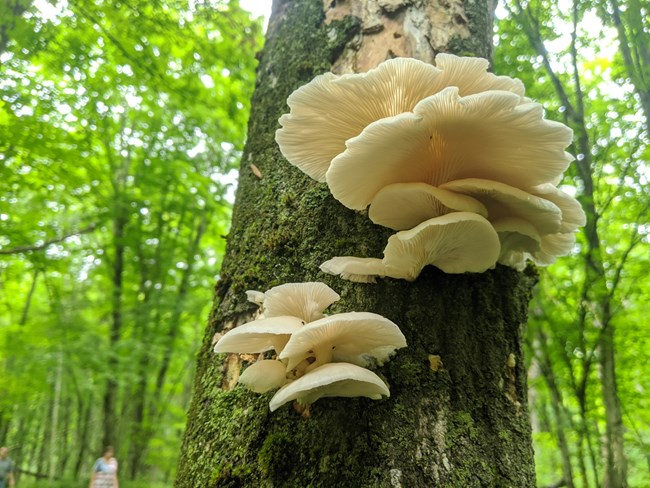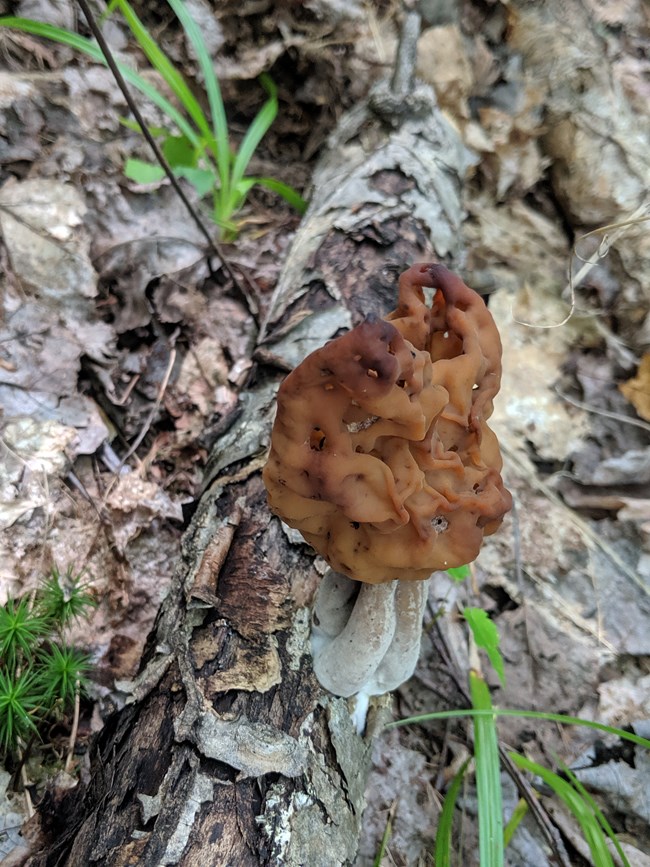
What Are Mushrooms?Mushrooms are the reproductive structures of certain members of the Kingdom fungi. The bulk of the organism is composed of root-like threads called hyphae, which often grow underground or in wood. Cumulatively, these threads form vast networks of hyphae known as mycelium. Mushroom-producing fungi make up a very small group within the fungal kingdom, but they are among the most easily visible due to their size. Some wild mushrooms look structurally similar to the mushrooms available in many grocery stores, with a stem and a cap with gills underneath. Others can have a sponge-like surface beneath the cap. Some don’t have caps at all and look like they would be more at home in a colorful coral reef than in the forest! Even if you don’t see any of these mushrooms above ground as you explore Pictured Rocks National Lakeshore, there is still a vast web of fungal life beneath your feet—recycling life and sending messages throughout the forest.
What Do Mushrooms Do?These small but numerous organisms are the original recyclers of nature. Often, we see mushrooms on organic material--clumped on dead trees, consuming downed rotten wood, or growing out of animal dung. They slowly decompose this material and return its nutrients to the soil, where the nutrients in turn help other plants to grow. Without mushrooms, the forest would take considerably longer to regenerate. Because they help so many ecosystems to recycle matter, mushrooms thrive almost anywhere in Pictured Rocks. However, most of the mushroom magic happens under the ground, where a large majority of the fungi lives. How Fungi Build a ForestUnderground, the fungi’s mycelium interact with the plant roots in a way that is beneficial to both organisms, also known as a symbiotic relationship. Some species of fungi form complex symbiotic relationships with the roots of trees and other plants. We describe these relationships as mycorrhizal (from the Latin myco-of fungi, and rhiza-root). Broad research indicates that mycorrhizal fungi can also connect plants to each other in important ways. Certain fungi have demonstrated the ability to stimulate immune responses within a community of plants when one of the individual plants is injured or threatened by a parasite! As scientists continue to examine these complex interactions, one thing has become clear: fungi form a vital part of a healthy and resilient forest ecosystem. Ninety-five percent of plants form partnerships with fungi through their roots. The fungi act as messengers within a forest through these relationships, allowing trees to send nutrients and warning messages to each other. Forests thus act as a whole with fungi as the thread connecting all the pieces together. While the majority of mycorrhizal fungi do not produce mushrooms at all, many well-known mushrooms do form these connections with plants, such as the oyster mushroom (Pleurotus species). Mushroom Foraging“There are bold mushroom hunters and old mushroom hunters, but there are no old, bold mushroom hunters.” - anonymous Better to merely enjoy the stunning beauty and diversity of the park’s mushrooms. 
Is it legal to pick mushrooms within the park boundaries?Yes, with restrictions. Visitors are permitted to pick one gallon of the fruiting bodies of fungi per person per day, and only for personal use or consumption. Harvesting for commercial use (selling to restaurants, grocery stores, etc.) is not permitted. While mushroom hunting, please strive to minimize your impact and always stay on the trail. Are there poisonous mushrooms? Absolutely! Pictured Rocks is home to many species of poisonous mushrooms that range from mildly toxic to deadly. Often, these species are difficult to distinguish from edible species even with extensive training and experience. Some poisonous species you are likely to encounter include the funeral bell (Galerina marginata), various Amanita species, and the false morel (Gyromitra). Only harvest mushrooms for the table if you are an experienced mushroom identifier and make sure you verify your findings with an expert. Your life could depend on it! I am interested in learning more about wild mushrooms! Where should I start? Many areas have local mushroom clubs, which provide great opportunities to learn from experts, get help with mushroom identification, and meet others who share your interest in fungi. Do some research and find out what clubs are active in your area! Additionally, invest in a few good field guides, especially those that are regionally focused. |
Last updated: September 8, 2021
